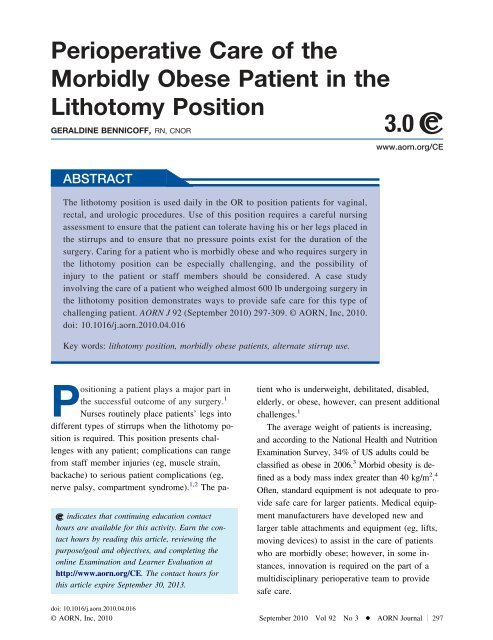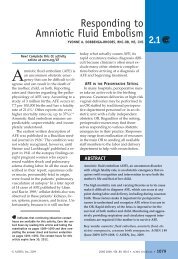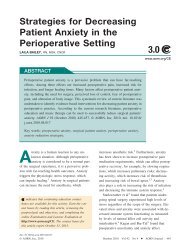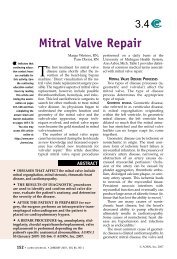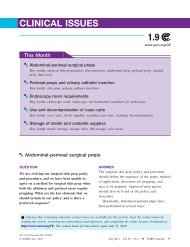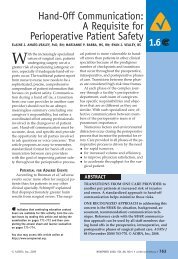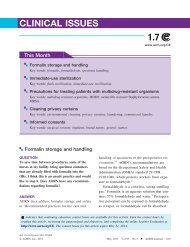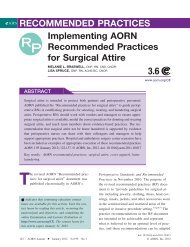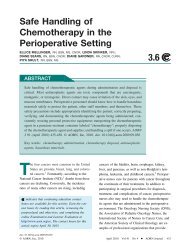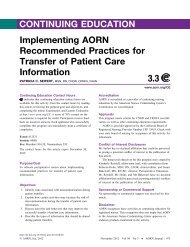Perioperative Care of the Morbidly Obese Patient in the ... - AORN
Perioperative Care of the Morbidly Obese Patient in the ... - AORN
Perioperative Care of the Morbidly Obese Patient in the ... - AORN
Create successful ePaper yourself
Turn your PDF publications into a flip-book with our unique Google optimized e-Paper software.
<strong>Perioperative</strong> <strong>Care</strong> <strong>of</strong> <strong>the</strong><strong>Morbidly</strong> <strong>Obese</strong> <strong>Patient</strong> <strong>in</strong> <strong>the</strong>Lithotomy PositionGERALDINE BENNICOFF, RN, CNOR3.0ABSTRACTThe lithotomy position is used daily <strong>in</strong> <strong>the</strong> OR to position patients for vag<strong>in</strong>al,rectal, and urologic procedures. Use <strong>of</strong> this position requires a careful nurs<strong>in</strong>gassessment to ensure that <strong>the</strong> patient can tolerate hav<strong>in</strong>g his or her legs placed <strong>in</strong><strong>the</strong> stirrups and to ensure that no pressure po<strong>in</strong>ts exist for <strong>the</strong> duration <strong>of</strong> <strong>the</strong>surgery. Car<strong>in</strong>g for a patient who is morbidly obese and who requires surgery <strong>in</strong><strong>the</strong> lithotomy position can be especially challeng<strong>in</strong>g, and <strong>the</strong> possibility <strong>of</strong><strong>in</strong>jury to <strong>the</strong> patient or staff members should be considered. A case study<strong>in</strong>volv<strong>in</strong>g <strong>the</strong> care <strong>of</strong> a patient who weighed almost 600 lb undergo<strong>in</strong>g surgery <strong>in</strong><strong>the</strong> lithotomy position demonstrates ways to provide safe care for this type <strong>of</strong>challeng<strong>in</strong>g patient. <strong>AORN</strong> J 92 (September 2010) 297-309. © <strong>AORN</strong>, Inc, 2010.doi: 10.1016/j.aorn.2010.04.016Key words: lithotomy position, morbidly obese patients, alternate stirrup use.www.aorn.org/CE<strong>in</strong>dicates that cont<strong>in</strong>u<strong>in</strong>g education contacthours are available for this activity. Earn <strong>the</strong> contacthours by read<strong>in</strong>g this article, review<strong>in</strong>g <strong>the</strong>purpose/goal and objectives, and complet<strong>in</strong>g <strong>the</strong>onl<strong>in</strong>e Exam<strong>in</strong>ation and Learner Evaluation athttp://www.aorn.org/CE. The contact hours forthis article expire September 30, 2013.Position<strong>in</strong>g a patient plays a major part <strong>in</strong><strong>the</strong> successful outcome <strong>of</strong> any surgery. 1Nurses rout<strong>in</strong>ely place patients’ legs <strong>in</strong>todifferent types <strong>of</strong> stirrups when <strong>the</strong> lithotomy positionis required. This position presents challengeswith any patient; complications can rangefrom staff member <strong>in</strong>juries (eg, muscle stra<strong>in</strong>,backache) to serious patient complications (eg,nerve palsy, compartment syndrome). 1,2 The patientwho is underweight, debilitated, disabled,elderly, or obese, however, can present additionalchallenges. 1The average weight <strong>of</strong> patients is <strong>in</strong>creas<strong>in</strong>g,and accord<strong>in</strong>g to <strong>the</strong> National Health and NutritionExam<strong>in</strong>ation Survey, 34% <strong>of</strong> US adults could beclassified as obese <strong>in</strong> 2006. 3 Morbid obesity is def<strong>in</strong>edas a body mass <strong>in</strong>dex greater than 40 kg/m 2 . 4Often, standard equipment is not adequate to providesafe care for larger patients. Medical equipmentmanufacturers have developed new andlarger table attachments and equipment (eg, lifts,mov<strong>in</strong>g devices) to assist <strong>in</strong> <strong>the</strong> care <strong>of</strong> patientswho are morbidly obese; however, <strong>in</strong> some <strong>in</strong>stances,<strong>in</strong>novation is required on <strong>the</strong> part <strong>of</strong> amultidiscipl<strong>in</strong>ary perioperative team to providesafe care.doi: 10.1016/j.aorn.2010.04.016© <strong>AORN</strong>, Inc, 2010 September 2010 Vol 92 No 3 ● <strong>AORN</strong> Journal 297
September 2010 Vol 92 No 3 BENNICOFFTHE LITHOTOMY POSITIONThe lithotomy position is used to allow maximumsurgical exposure <strong>in</strong> vag<strong>in</strong>al, rectal, and urologicprocedures. There are four levels <strong>of</strong> <strong>the</strong> lithotomyposition rang<strong>in</strong>g from low lithotomy, whichplaces a patient’s legs at approximately a35-degree angle to his or her recumbent torso, to<strong>the</strong> exaggerated lithotomy position with <strong>the</strong> patient’slegs at more than a 90-degree angle. 5<strong>Patient</strong> leg abductionshould be limited to<strong>the</strong> degree neededfor adequate surgicalexposure to avoidstress on <strong>the</strong> patient’ship jo<strong>in</strong>ts andprevent compromise<strong>of</strong> lower extremitycirculation. 6 Physiologicresponses, <strong>in</strong>clud<strong>in</strong>g musculoskeletal, cutaneousand neurologic, and respiratory and hemodynamicresponses occur when <strong>the</strong> patient’s legsare elevated <strong>in</strong>to lithotomy stirrups; perioperativeteam members must take <strong>the</strong>se issues <strong>in</strong>to considerationwhen car<strong>in</strong>g for patients undergo<strong>in</strong>g surgerythat requires <strong>the</strong> lithotomy position. 1,5,7Potential Musculoskeletal ComplicationsInjuries to <strong>the</strong> patient’s hips and knees can resultfrom lithotomy position<strong>in</strong>g. Abductor muscles andhip capsule jo<strong>in</strong>t problems can develop if <strong>the</strong> patient’slegs are stretched or <strong>the</strong> patient rema<strong>in</strong>s <strong>in</strong><strong>the</strong> lithotomy position for an extended period.The patient’s f<strong>in</strong>gers, if tucked at his or her sides,are <strong>in</strong> danger <strong>of</strong> <strong>in</strong>jury when <strong>the</strong> bottom <strong>of</strong> <strong>the</strong>OR bed is raised or lowered. 5Potential Cutaneous andNeurologic ComplicationsS<strong>of</strong>t tissue problems can result from <strong>in</strong>correcthandl<strong>in</strong>g or position<strong>in</strong>g by health care providersand can <strong>in</strong>clude <strong>in</strong>juries to <strong>the</strong> patient’s femoral,cutaneous, sciatic, and obturator nerves. Pressurepo<strong>in</strong>ts from <strong>in</strong>adequate padd<strong>in</strong>g and position<strong>in</strong>gmay cause tissue damage. Shear<strong>in</strong>g force fromchanges <strong>in</strong> position can damage sk<strong>in</strong> tissue, especially<strong>in</strong> patients who are older, debilitated, orobese. Proper patient-mov<strong>in</strong>g techniques shouldbe used to prevent shear<strong>in</strong>g forces.Potential Respiratory andHemodynamic ComplicationsRespiratory complications can occur because <strong>the</strong>patient’s abdom<strong>in</strong>al organs shift when <strong>the</strong> patient’slegs are raised and placed <strong>in</strong> stirrups. This<strong>in</strong>creases pressure on<strong>the</strong> diaphragm andcan result <strong>in</strong> respiratorycompromise. 5Rais<strong>in</strong>g or lower<strong>in</strong>g<strong>the</strong> patient’s legs toorapidly can result <strong>in</strong>fluid volume shiftsthat affect bloodpressure. When teammembers lower <strong>the</strong> patient’s legs after <strong>the</strong> procedure,fluid volume deficits can quickly becomemore obvious, mak<strong>in</strong>g <strong>the</strong> patient’s hemodynamicstatus unstable and complicat<strong>in</strong>g <strong>the</strong> anes<strong>the</strong>siacare provider’s management <strong>of</strong> <strong>the</strong> patient. 5<strong>Patient</strong>s who are morbidly obese can experience<strong>the</strong> common position<strong>in</strong>g problems that placeany patient at risk, and morbid obesity <strong>in</strong>creasesa patient’s risk <strong>of</strong> additional complications that<strong>the</strong> nurse must consider <strong>in</strong> <strong>the</strong> plan <strong>of</strong> care.GENERAL NURSING CARE FOR PATIENTSWHO ARE MORBIDLY OBESE<strong>Patient</strong>s who are morbidly obese present specialchallenges to all members <strong>of</strong> <strong>the</strong> perioperativeteam. These patients can experience any <strong>of</strong> <strong>the</strong>common position<strong>in</strong>g problems that place any patientat risk; however, morbid obesity <strong>in</strong>creases apatient’s risk <strong>of</strong> additional complications thatmust be considered <strong>in</strong> <strong>the</strong> plan <strong>of</strong> care (Table 1). 8Nurs<strong>in</strong>g <strong>in</strong>terventions to prevent problems <strong>in</strong>cludeensur<strong>in</strong>g that sequential compression stock<strong>in</strong>gs fitto prevent constriction and monitor<strong>in</strong>g <strong>the</strong> patient’scloth<strong>in</strong>g and bed l<strong>in</strong>en to prevent constrictionand prevent <strong>the</strong> patient from ly<strong>in</strong>g onbunched or wr<strong>in</strong>kled material that could causetissue damage. Drapes must be large enough tocover <strong>the</strong> patient and provide a sterile field. Instrumentsmust be large enough to provide adequateexposure and allow <strong>the</strong> surgeon to perform298 <strong>AORN</strong> Journal
CARE OF THE OBESE PATIENT IN LITHOTOMYwww.aornjournal.org<strong>the</strong> planned procedure, which may require specialbariatric <strong>in</strong>strument sets.Potential Musculoskeletal ComplicationsAs a result <strong>of</strong> <strong>the</strong> patient’s size and potential mobilitydifficulties, rout<strong>in</strong>e care may be more complicatedand require <strong>the</strong> help <strong>of</strong> additional supportpersonnel to avoid <strong>in</strong>jury to <strong>the</strong> patient or staffmembers. 1,5,7 There is an <strong>in</strong>creased risk <strong>of</strong> <strong>in</strong>jur<strong>in</strong>g<strong>the</strong> patient’s jo<strong>in</strong>ts, muscles, nerves, and s<strong>of</strong>ttissues when lift<strong>in</strong>g and mov<strong>in</strong>g <strong>the</strong> patient because<strong>of</strong> his or her size, and <strong>the</strong> <strong>in</strong>ability <strong>of</strong>health care providers to clearly see <strong>the</strong> patient’sanatomic markers (eg, jo<strong>in</strong>ts) can make safe kneeand hip flexion difficult to determ<strong>in</strong>e. 1,5,7 Overabductioncan occur because <strong>of</strong> <strong>the</strong> size and weight<strong>of</strong> <strong>the</strong> patient’s thighs and <strong>the</strong> need to create adequatespace <strong>in</strong> which <strong>the</strong> surgeon and staffmembers can work. 1,5,7 For example, <strong>the</strong> nurseshould have additional personnel support <strong>the</strong>patient’s legs and prevent overabduction whenplac<strong>in</strong>g <strong>the</strong> patient <strong>in</strong> <strong>the</strong> frog leg position dur<strong>in</strong>g<strong>in</strong>sertion <strong>of</strong> an <strong>in</strong>dwell<strong>in</strong>g ur<strong>in</strong>ary ca<strong>the</strong>ter.Potential Anes<strong>the</strong>tic Complications<strong>Patient</strong>s who are morbidly obese present significantchallenges for <strong>the</strong> anes<strong>the</strong>sia care provider.Often, <strong>the</strong>se patients experience medication problemsas a result <strong>of</strong> altered absorption and <strong>in</strong>creasedstorage <strong>of</strong> medications <strong>in</strong> <strong>the</strong>ir excess fat.Cardiovascular and respiratory concerns may <strong>in</strong>clude<strong>in</strong>creased cardiac afterload, decreased oxygensupply, and a respiratory system taxed by<strong>in</strong>creased fat metabolism. 9 Additional chestweight, abdom<strong>in</strong>al pressure, and <strong>the</strong> presence <strong>of</strong>coexist<strong>in</strong>g conditions unrelated to <strong>the</strong> procedure(eg, hiatal hernia, sleep apnea) <strong>in</strong>crease <strong>the</strong> patient’srespiratory workload. The patient’s chestweight and abdom<strong>in</strong>al pressure also <strong>in</strong>crease <strong>the</strong>patient’s risk <strong>of</strong> aspiration and its serious consequences.9 Intubat<strong>in</strong>g a patient who is morbidlyobese can be difficult because <strong>of</strong> limited cervicalneck movement, reduced oxygen reserves, and<strong>in</strong>creased oxygen consumption. 9 Anes<strong>the</strong>sia careproviders may have difficulty see<strong>in</strong>g <strong>the</strong> vocalcords because <strong>of</strong> limited neck movement and fatdeposits that can obstruct <strong>the</strong> airway. As a result<strong>of</strong> <strong>the</strong>se complications, <strong>in</strong>tubat<strong>in</strong>g <strong>the</strong> patientwhile he or she is awake may be necessary. 9 Theanes<strong>the</strong>sia care provider may require special headposition<strong>in</strong>g and support aids such as an airwaymanagement head cradle and an elevation wedgespecifically designed to assist with <strong>in</strong>duction andhead support dur<strong>in</strong>g procedures on patients whoare obese. Emergency response carts also shouldbe <strong>in</strong> <strong>the</strong> room <strong>in</strong> <strong>the</strong> event <strong>of</strong> a difficult <strong>in</strong>tubationor o<strong>the</strong>r emergency. The patient also mayrequire appropriately sized blood pressure cuffs.Potential Cardiovascular ComplicationsCardiac conditions that <strong>of</strong>ten present <strong>in</strong> patientswho are morbidly obese may <strong>in</strong>clude hypertension,diabetes, bradycardia or tachycardia, andslow cardiac conduction and ischemia. As a complicat<strong>in</strong>gfactor, <strong>the</strong> electrocardiogram conductionsignal may be distorted as a result <strong>of</strong> excess chestfat. Fur<strong>the</strong>rmore, patients who are obese have an<strong>in</strong>creased <strong>in</strong>cidence <strong>of</strong> deep ve<strong>in</strong> thrombosis, andsuperficial ve<strong>in</strong>s may be difficult to access for IVplacement. 9PLACING THE PATIENT WHO ISMORBIDLY OBESE IN THELITHOTOMY POSITION“<strong>Obese</strong> patients are more prone to difficulty withposition<strong>in</strong>g and position<strong>in</strong>g <strong>in</strong>juries dur<strong>in</strong>g surgerybecause <strong>of</strong> <strong>the</strong> stra<strong>in</strong> excessive weight places on<strong>the</strong>ir musculoskeletal and nervous systems.” 9(p45)<strong>Patient</strong>s who are obese also may present with exist<strong>in</strong>gareas <strong>of</strong> sk<strong>in</strong> damage that need to be assessedand taken <strong>in</strong>to consideration dur<strong>in</strong>g position<strong>in</strong>g.It is imperative that <strong>the</strong> perioperative nurse hasa preoperative discussion with <strong>the</strong> surgeon and<strong>the</strong> anes<strong>the</strong>sia care provider about plans andneeds for <strong>the</strong> surgery. The circulat<strong>in</strong>g nurseshould perform a careful preoperative assessment<strong>of</strong> <strong>the</strong> patient to identify cardiac, vascular, or neurologicconditions that could affect <strong>the</strong> patient’ssafety or care dur<strong>in</strong>g surgery. Additionally, <strong>the</strong>nurse should identify any issues that might<strong>AORN</strong> Journal 299
September 2010 Vol 92 No 3 BENNICOFFTABLE 1. Nurs<strong>in</strong>g <strong>Care</strong> Plan for <strong>Patient</strong>s Who Are <strong>Morbidly</strong> <strong>Obese</strong>Diagnosis Nurs<strong>in</strong>g <strong>in</strong>terventions Outcome <strong>in</strong>dicator Outcome statementBody imagedisturbance Identifies psychosocial status Assesses cop<strong>in</strong>g mechanisms Identifies barriers tocommunication Identifies <strong>the</strong> patient’s anddesignated support person’seducational needs Identifies expectations <strong>of</strong> homecare Implements measures to providepsychological support Includes <strong>the</strong> patient anddesignated support person <strong>in</strong>perioperative teach<strong>in</strong>g Expla<strong>in</strong>s <strong>the</strong> expected sequence <strong>of</strong>events Provides status reports to <strong>the</strong>designated support person Evaluates psychosocial responseto <strong>the</strong> plan <strong>of</strong> care Evaluates response to <strong>in</strong>structions The patient verbalizes <strong>the</strong>sequence <strong>of</strong> events to expectbefore and immediately aftersurgery. The patient states realisticexpectations regard<strong>in</strong>grecovery from <strong>the</strong> procedure. The patient ordesignated supportperson demonstratesknowledge <strong>of</strong> <strong>the</strong>expected responses to<strong>the</strong> operative or <strong>in</strong>vasiveprocedure.Imbalanced nutrition:more than bodyrequirements or<strong>in</strong>effective healthma<strong>in</strong>tenance Identifies basel<strong>in</strong>e gastro<strong>in</strong>test<strong>in</strong>alstatus Assesses nutritional habits andpatterns Assesses psychosocial issuesspecific to <strong>the</strong> patient’s nutritionalstatus Includes <strong>the</strong> patient anddesignated support person <strong>in</strong>perioperative teach<strong>in</strong>g Provides <strong>in</strong>struction regard<strong>in</strong>gdietary needs Evaluates response to <strong>in</strong>structions Evaluates response to nutritional<strong>in</strong>struction The patient verbalizescompliance with food andfluid restrictions beforesurgery. The patient describes <strong>the</strong>recommended postoperativenutritional <strong>in</strong>take regimen for<strong>the</strong> recovery period at <strong>the</strong>time <strong>of</strong> discharge. The patient ordesignated supportperson demonstratesknowledge <strong>of</strong> nutritionalmanagement related to<strong>the</strong> operative or <strong>in</strong>vasiveprocedure.Ineffective family<strong>the</strong>rapeuticregimenmanagement orcompromisedfamily cop<strong>in</strong>g Develops an <strong>in</strong>dividualized plan <strong>of</strong>care Consults with appropriate healthcare providers to <strong>in</strong>itiate newtreatments or change exist<strong>in</strong>gtreatments M<strong>in</strong>imizes <strong>the</strong> length <strong>of</strong> <strong>the</strong>operative or <strong>in</strong>vasive procedure byplann<strong>in</strong>g care Uses a cl<strong>in</strong>ical pathway Ensures cont<strong>in</strong>uity <strong>of</strong> care The patient reports that<strong>in</strong>dividual choices werehonored before and aftersurgery. The patient’s care isconsistent with <strong>the</strong><strong>in</strong>dividualizedperioperative plan <strong>of</strong>care.(table cont<strong>in</strong>ued)300 <strong>AORN</strong> Journal
CARE OF THE OBESE PATIENT IN LITHOTOMYwww.aornjournal.orgTABLE 1. (cont<strong>in</strong>ued) Nurs<strong>in</strong>g <strong>Care</strong> Plan for <strong>Patient</strong>s Who Are <strong>Morbidly</strong> <strong>Obese</strong>Diagnosis Nurs<strong>in</strong>g <strong>in</strong>terventions Outcome <strong>in</strong>dicator Outcome statementRisk <strong>of</strong> perioperativeposition<strong>in</strong>g <strong>in</strong>jury Assesses basel<strong>in</strong>e sk<strong>in</strong> condition Identifies basel<strong>in</strong>e cardiac status Identifies basel<strong>in</strong>e tissue perfusion Identifies basel<strong>in</strong>e musculoskeletalstatus Identifies physical alterations thatrequire additional precautions forprocedure-specific position<strong>in</strong>g Verifies presence <strong>of</strong> pros<strong>the</strong>tics orcorrective devices Positions <strong>the</strong> patient Implements protective measuresto prevent sk<strong>in</strong>/tissue <strong>in</strong>jurycaused by mechanical sources Applies safety devices Evaluates tissue perfusion Evaluates musculoskeletal status Evaluates for signs and symptoms<strong>of</strong> physical <strong>in</strong>jury to sk<strong>in</strong> and tissue The patient’s pressure po<strong>in</strong>tsdemonstrate hyperemia forless than 30 m<strong>in</strong>utes. The patient has full return <strong>of</strong>movement <strong>of</strong> extremities at<strong>the</strong> time <strong>of</strong> discharge from<strong>the</strong> OR or procedure room. The patient is free fromsigns and symptoms <strong>of</strong><strong>in</strong>jury related toposition<strong>in</strong>g.Risk <strong>of</strong> impaired sk<strong>in</strong><strong>in</strong>tegrity, risk <strong>of</strong>falls, impaired bedmobility, orimpaired transferability Confirms patient identity Assesses basel<strong>in</strong>e sk<strong>in</strong> condition Identifies basel<strong>in</strong>e musculoskeletalstatus Transports accord<strong>in</strong>g to <strong>in</strong>dividualneeds Evaluates for signs and symptoms<strong>of</strong> physical <strong>in</strong>jury to sk<strong>in</strong> and tissue Evaluates musculoskeletal status The patient reports be<strong>in</strong>gcomfortable when recl<strong>in</strong>ed on<strong>the</strong> transport equipment/device. The patient is free from signsand symptoms <strong>of</strong> <strong>in</strong>juryrelated to transfer/transporton discharge from <strong>the</strong> OR orprocedure room. The patient’s sk<strong>in</strong> is warm,dry, and free from edema.Capillary refill and SaO 2 showadequate tissue perfusion. The patient is free fromsigns and symptoms <strong>of</strong><strong>in</strong>jury related to transfer/transport. The patient’s tissueperfusion is consistentwith or improved frombasel<strong>in</strong>e levels.Ineffective breath<strong>in</strong>gpattern, <strong>in</strong>effectiveairway clearance,impaired gasexchange, risk <strong>of</strong>aspiration, oranxiety Identifies basel<strong>in</strong>e respiratorystatus Identifies physiologic status Reports deviation <strong>in</strong> diagnosticstudy results Reports deviation <strong>in</strong> arterial bloodgas studies Monitors physiologic parameters Monitors changes <strong>in</strong> respiratorystatus Uses monitor<strong>in</strong>g equipment toassess respiratory status Evaluates respiratory status The patient is breath<strong>in</strong>gspontaneously withsupplemental oxygen withoutassistance on transfer at <strong>the</strong>time <strong>of</strong> discharge from <strong>the</strong>OR or procedure room to <strong>the</strong>postoperative unit. The patient’s SaO 2 andrespiratory rate are <strong>in</strong> <strong>the</strong>expected range at dischargefrom <strong>the</strong> postoperative careunit. The patient’s respiratorystatus is ma<strong>in</strong>ta<strong>in</strong>ed orimproved from basel<strong>in</strong>elevels.SaO 2 arterial oxygen saturation.<strong>AORN</strong> Journal 301
September 2010 Vol 92 No 3 BENNICOFFadversely affect <strong>the</strong> patient when he or she isplaced <strong>in</strong> <strong>the</strong> lithotomy position, such as<strong>in</strong>ability to tolerate <strong>the</strong> lithotomy position,restrictions to mobility or jo<strong>in</strong>t range <strong>of</strong> motion,andconditions <strong>of</strong> <strong>the</strong> sk<strong>in</strong> or circulation.The nurse should note any concerns <strong>in</strong> <strong>the</strong> patient’smedical record and convey <strong>the</strong>se concernsto <strong>the</strong> surgical team.Assembl<strong>in</strong>g additional staff members to helpdur<strong>in</strong>g mov<strong>in</strong>g and position<strong>in</strong>g also prevents <strong>in</strong>juriesto staff members. A verbal walk-through <strong>of</strong><strong>the</strong> planned move and position<strong>in</strong>g needs can helpreduce <strong>in</strong>juries. Depend<strong>in</strong>g on <strong>the</strong> patient’s statusand <strong>the</strong> surgical exposure needs, team membersmay need to experiment with position<strong>in</strong>g with avolunteer staff member stand<strong>in</strong>g <strong>in</strong> for <strong>the</strong> patient.The RN <strong>in</strong> charge <strong>of</strong> <strong>the</strong> patient should act as<strong>the</strong> person <strong>in</strong> charge <strong>of</strong> <strong>the</strong> move to reduceconfusion and prevent <strong>in</strong>jury to <strong>the</strong> patient orstaff members. Before tak<strong>in</strong>g <strong>the</strong> patient <strong>in</strong>to <strong>the</strong>OR, <strong>the</strong> nurse should ensure that all position<strong>in</strong>gequipment (eg, heavy-duty stirrups, gel pads, pillows)is available, is <strong>in</strong> position, and has beenchecked for function and safety. Transport<strong>in</strong>g patientswho are obese may necessitate <strong>the</strong> use <strong>of</strong>special assistance devices or carts.Equipment (eg, OR bed, stirrups, arm boards)must support <strong>the</strong> patient’s weight and fit <strong>the</strong> extremitiesto avoid caus<strong>in</strong>g <strong>in</strong>jury. When car<strong>in</strong>g forpatients who are morbidly obese, <strong>the</strong> surgicalteam must modify many aspects <strong>of</strong> rout<strong>in</strong>e care todeal with <strong>the</strong> patient’s larger size and weight. Abariatric OR bed is needed that can support <strong>the</strong>patient’s weight and provide additional width.Typical bariatric beds are capable <strong>of</strong> support<strong>in</strong>gup to 1,000 lb and are extra wide, and <strong>the</strong> mattressesare well constructed to help prevent fullcompression <strong>of</strong> <strong>the</strong> mattress. O<strong>the</strong>r equipmentconsiderations <strong>in</strong>clude provid<strong>in</strong>g appropriatelysized arm boards and safety belts for <strong>the</strong> bed. Devicesto support <strong>the</strong> extremities (eg, sl<strong>in</strong>gs) maybe needed.Bariatric stirrups should hold up to an 800-lbpatient, but stirrups manufactured for bariatricbeds must be assessed for each patient. For <strong>in</strong>stance,although <strong>the</strong> stirrup could support <strong>the</strong>weight <strong>of</strong> <strong>the</strong> patient’s leg, <strong>the</strong> sides <strong>of</strong> <strong>the</strong> bootmay be too narrow to accommodate <strong>the</strong> size andcircumference <strong>of</strong> <strong>the</strong> leg without creat<strong>in</strong>g pressure.<strong>Perioperative</strong> team members may have toimprovise stirrups to accommodate <strong>the</strong> patientwithout caus<strong>in</strong>g problems. Methods to improviseshould not be undertaken that would contradict<strong>the</strong> manufacturer’s <strong>in</strong>structions for use or negate<strong>the</strong> product warranty, however.Different types <strong>of</strong> stirrups are available for <strong>the</strong>lithotomy position, but candy-cane shaped, kneecrutch,and boot-type stirrups are used most <strong>of</strong>ten.Instructions for use from <strong>the</strong> manufacturer and<strong>AORN</strong> position<strong>in</strong>g recommendations should alwaysbe followed dur<strong>in</strong>g use <strong>of</strong> position<strong>in</strong>g aids,<strong>in</strong>clud<strong>in</strong>g stirrups. 1 Candy-cane shaped stirrupsprovide good exposure <strong>of</strong> <strong>the</strong> surgical site, areeasy to use, and allow room for <strong>the</strong> team to work.Knee-crutch stirrups are commonly used dur<strong>in</strong>gcystoscopy procedures, which tend to be shorter<strong>in</strong> duration. Boot-type stirrups are <strong>of</strong>ten used dur<strong>in</strong>gprocedures <strong>in</strong> which <strong>the</strong> patient is awake (eg,local anes<strong>the</strong>sia, monitored anes<strong>the</strong>sia care) because<strong>the</strong>y allow <strong>the</strong> patient’s legs to be <strong>in</strong> alower, more comfortable position and can beraised if necessary. Use <strong>of</strong> each type <strong>of</strong> stirruphas <strong>the</strong> potential to cause problems (eg, nerve orpressure <strong>in</strong>juries, overrotation).Candy-Cane Shaped StirrupsThese stirrups look similar to a cane and are attachedto <strong>the</strong> side <strong>of</strong> <strong>the</strong> OR bed (Figure 1). Afterattach<strong>in</strong>g <strong>the</strong> stirrups to <strong>the</strong> bed, perioperativepersonnel can rotate <strong>the</strong>m to change <strong>the</strong> angle atwhich <strong>the</strong> stirrups hold <strong>the</strong> legs. The patient’sfoot is secured <strong>in</strong> a double sl<strong>in</strong>g made <strong>of</strong> cottonwebb<strong>in</strong>g and suspended from <strong>the</strong> end <strong>of</strong> <strong>the</strong> caneby a fastener. Injury can occur if <strong>the</strong> patient’slegs are allowed to relax and extend outward torest on <strong>the</strong> cane bar. 2 Pressure from <strong>the</strong> cane bar302 <strong>AORN</strong> Journal
CARE OF THE OBESE PATIENT IN LITHOTOMYwww.aornjournal.orgFigure 1. Candy-cane shaped stirrups.on <strong>the</strong> lateral aspect <strong>of</strong> <strong>the</strong> calf or knee can result<strong>in</strong> footdrop or nerve <strong>in</strong>jury to <strong>the</strong> leg. Althoughpadd<strong>in</strong>g can be placed between <strong>the</strong> cane bar and<strong>the</strong> patient’s leg, pressure <strong>in</strong>jury can still occur.The patient’s hips can be externally overrotatedwhen <strong>in</strong> <strong>the</strong>se stirrups to a po<strong>in</strong>t <strong>of</strong> hyperabduction,2 which can cause sciatic and obturator nerve<strong>in</strong>jury and <strong>in</strong>jury to <strong>the</strong> patient’s hip and kneejo<strong>in</strong>ts and leg muscles. Gel boots and wide strapscan pad and reduce pressure to <strong>the</strong> ankle andfoot. The patient’s leg weight and <strong>the</strong> duration <strong>of</strong><strong>the</strong> procedure can <strong>in</strong>crease <strong>the</strong> potential for fur<strong>the</strong>r<strong>in</strong>jury to <strong>the</strong> distal sural and plantar nerves.Knee-Crutch StirrupsThese stirrups resemble <strong>the</strong> top <strong>of</strong> a walk<strong>in</strong>gcrutch (Figure 2). The nurse places <strong>the</strong> patient’sleg over <strong>the</strong> crutch and positions <strong>the</strong> leg so it isrest<strong>in</strong>g over <strong>the</strong> support<strong>in</strong>g arch. All weight isrest<strong>in</strong>g on <strong>the</strong> knee, which can put undue pressureFigure 2. Knee-crutch stirrups.Figure 3. Boot-type stirrups.on <strong>the</strong> popliteal space. Knee-crutch stirrups alsohave <strong>the</strong> potential to cause <strong>in</strong>jury to <strong>the</strong> posteriorand <strong>the</strong> common peroneal nerves and <strong>the</strong> poplitealartery because <strong>the</strong>y place pressure on <strong>the</strong> poplitealfossae and may not evenly distribute pressure. 2Boot-Type StirrupsThese stirrups resemble boots attached to <strong>the</strong>sides <strong>of</strong> <strong>the</strong> OR bed and give more support to <strong>the</strong>entire leg (Figure 3). They are commonly usedfor procedures <strong>in</strong> which <strong>the</strong> patient is receiv<strong>in</strong>glocal anes<strong>the</strong>sia or monitored anes<strong>the</strong>sia care aswell as dur<strong>in</strong>g pelviscopy procedures. The supportthat boot-type stirrups provide reduces <strong>the</strong> potentialfor nerve and pressure <strong>in</strong>jury because pressureis evenly distributed to <strong>the</strong> leg and foot; however,<strong>the</strong> same types <strong>of</strong> <strong>in</strong>juries that occur with o<strong>the</strong>rstirrups can occur when <strong>the</strong>se stirrups are used.Boot-type stirrups are attached to <strong>the</strong> bed at <strong>the</strong>level <strong>of</strong> <strong>the</strong> patient’s hip socket and reduce stresson <strong>the</strong> hip jo<strong>in</strong>t. It is important to remember that<strong>the</strong>se stirrups may appear easier to use, but <strong>in</strong>correctplacement <strong>of</strong> <strong>the</strong> bed attachment bracket cancause stress <strong>in</strong>jury to <strong>the</strong> patient’s hip.General Concerns With AnyType <strong>of</strong> StirrupIn general, stirrups are secured on <strong>the</strong> OR bedrails at <strong>the</strong> level <strong>of</strong> <strong>the</strong> patient’s hip socket, with<strong>the</strong> patient’s buttocks at <strong>the</strong> end <strong>of</strong> <strong>the</strong> break <strong>in</strong><strong>the</strong> bed. The nurse can adjust <strong>the</strong> height <strong>of</strong> <strong>the</strong>boot or foot location to match <strong>the</strong> patient’s legsize. To prevent shear<strong>in</strong>g <strong>in</strong>juries, care should be<strong>AORN</strong> Journal 303
September 2010 Vol 92 No 3 BENNICOFFtaken to use transfer devices to lift, not slide orpull, <strong>the</strong> patient if reposition<strong>in</strong>g <strong>the</strong> patient to <strong>the</strong>break <strong>in</strong> <strong>the</strong> bed is necessary. When plac<strong>in</strong>g anormal-weight patient <strong>in</strong>to <strong>the</strong> lithotomy position,two team members lift, slightly externally rotate,and flex <strong>the</strong> patient’s legs and raise <strong>the</strong>m toge<strong>the</strong>rwhile hold<strong>in</strong>g <strong>the</strong>feet and support<strong>in</strong>g<strong>the</strong> calves close to<strong>the</strong> knee jo<strong>in</strong>ts.When <strong>the</strong> leg is at anappropriate level, <strong>the</strong>team members place<strong>the</strong> patient’s feet <strong>in</strong><strong>the</strong> stirrups. If us<strong>in</strong>gcandy-cane shaped stirrups, staff members shouldplace <strong>the</strong> gel boots or straps on <strong>the</strong> patient beforerais<strong>in</strong>g <strong>the</strong> legs. This decreases <strong>the</strong> difficulty <strong>of</strong>gett<strong>in</strong>g <strong>the</strong> foot <strong>in</strong>to <strong>the</strong> strap while hold<strong>in</strong>g <strong>the</strong>leg, which <strong>the</strong>n provides safer lift<strong>in</strong>g <strong>of</strong> <strong>the</strong> leg to<strong>the</strong> stirrup attachment. Several staff members maybe needed to lift each leg if <strong>the</strong> patient is morbidlyobese, or pneumatic sl<strong>in</strong>gs may be requiredto position <strong>the</strong> patient’s legs; no one personshould attempt to lift <strong>the</strong> extremity alone. Abduction<strong>of</strong> <strong>the</strong> patient’s legs should be limited to <strong>the</strong>degree needed for good surgical exposure, and <strong>the</strong>position should not allow ei<strong>the</strong>r leg to hyperrotateor hyperextend. The nurse should gently secure<strong>the</strong> patient’s arms on padded arm boards at lessthan a 90-degree angle and ensure that <strong>the</strong> patient’shands, if placed at <strong>the</strong> sides <strong>of</strong> <strong>the</strong> OR bed,are clear <strong>of</strong> <strong>the</strong> breaks <strong>in</strong> <strong>the</strong> bed to prevent <strong>in</strong>jurywhen <strong>the</strong> bottom <strong>of</strong> <strong>the</strong> bed is lowered. 2The circulat<strong>in</strong>g nurse should assess <strong>the</strong> patientthoroughly after <strong>the</strong> team has completed position<strong>in</strong>g.He or she should check <strong>the</strong> patient for alignment,possible pressure po<strong>in</strong>ts and potential sites<strong>of</strong> <strong>in</strong>jury (eg, sacrum, arms, hands), and o<strong>the</strong>rpotential problems (eg, respiratory or circulatorycompromise as a result <strong>of</strong> leg position<strong>in</strong>g) andmake any necessary adjustments. The nurse alsoshould check <strong>the</strong> patient’s positionAfter <strong>the</strong> team has completed position<strong>in</strong>g, <strong>the</strong>circulat<strong>in</strong>g nurse should assess <strong>the</strong> patientthoroughly for alignment, possible pressurepo<strong>in</strong>ts and potential sites <strong>of</strong> <strong>in</strong>jury, and makeany necessary adjustments. at regular <strong>in</strong>tervals dur<strong>in</strong>g <strong>the</strong> procedure, each time <strong>the</strong> patient’s position is changed,and when <strong>the</strong> patient has been <strong>in</strong> <strong>the</strong> lithotomyposition for a prolonged period (ie, more thanfour hours).Procedural timeshould be kept to am<strong>in</strong>imum. <strong>AORN</strong>’s“Recommended practicesfor position<strong>in</strong>g<strong>the</strong> patient <strong>in</strong> <strong>the</strong>perioperative practicesett<strong>in</strong>g” suggests that<strong>the</strong> perioperativeteam should consider reposition<strong>in</strong>g <strong>the</strong> patient if<strong>the</strong> procedure lasts longer than four hours. 1 Thecirculat<strong>in</strong>g nurse should <strong>the</strong>n document all position<strong>in</strong>gand <strong>the</strong> names <strong>of</strong> <strong>the</strong> staff members <strong>in</strong>volvedas well as all equipment and padd<strong>in</strong>g used.Before mov<strong>in</strong>g any lower extremity <strong>in</strong>to or out<strong>of</strong> stirrups, team members should alert <strong>the</strong> anes<strong>the</strong>siacare provider. When <strong>the</strong> anes<strong>the</strong>sia careprovider is ready, team members should remove<strong>the</strong> patient’s legs from <strong>the</strong> stirrups simultaneouslyand slowly to m<strong>in</strong>imize lumbosacral stra<strong>in</strong> on <strong>the</strong>patient. If possible, staff members should br<strong>in</strong>g<strong>the</strong> patient’s legs toge<strong>the</strong>r simultaneously and<strong>the</strong>n lower <strong>the</strong> patient’s legs to <strong>the</strong> bed surfaceone at a time to prevent rapid or unexpected circulatorychanges. 1(p339) Before <strong>the</strong> patient istransferred to <strong>the</strong> postanes<strong>the</strong>sia care unit, <strong>the</strong>circulat<strong>in</strong>g nurse should carefully assess <strong>the</strong> patientfor sk<strong>in</strong>, nerve, or pressure <strong>in</strong>jury.CASE STUDYTwo weeks before a scheduled surgery, perioperativeteam members were notified <strong>of</strong> a lithotomyprocedure to be performed on a patient weigh<strong>in</strong>gapproximately 600 lb. Previously, a physician hadattempted to perform an exam<strong>in</strong>ation with thispatient under anes<strong>the</strong>sia, and staff members hadbeen unable to position <strong>the</strong> patient or support herlegs <strong>in</strong> a way that would work for <strong>the</strong> surgeon304 <strong>AORN</strong> Journal
CARE OF THE OBESE PATIENT IN LITHOTOMYwww.aornjournal.organd be safe for <strong>the</strong> patient and staff members.Stability, position<strong>in</strong>g, and padd<strong>in</strong>g needs couldnot be met, so <strong>the</strong> exam<strong>in</strong>ation had been cancelled.After talk<strong>in</strong>g with this physician, <strong>the</strong> surgicalteam members determ<strong>in</strong>ed that stirrups availableat <strong>the</strong> facility, even <strong>the</strong> ones used forbariatric surgery patients, would not fit this patient.The gynecology coord<strong>in</strong>ator, circulat<strong>in</strong>gnurse, scrub person, and facility safety <strong>of</strong>ficer met<strong>in</strong> advance <strong>of</strong> <strong>the</strong> procedure to develop a safe lithotomy position<strong>in</strong>g devicefor a patient who is morbidly obese; collect, set up, and test equipment; review potential position<strong>in</strong>g risks for <strong>the</strong> patientand staff members; and determ<strong>in</strong>e how to prevent pressure <strong>in</strong>jury, provide adequate exposure for <strong>the</strong> surgeon, prevent <strong>the</strong> patient’s position from compromis<strong>in</strong>ganes<strong>the</strong>sia care, and provide safe, effective care for <strong>the</strong> patient.The gynecology coord<strong>in</strong>ator contacted <strong>the</strong> facility’sstirrup vendor to see whe<strong>the</strong>r any currentlymanufactured stirrups would work for apatient <strong>of</strong> this size. The vendor was not able t<strong>of</strong><strong>in</strong>d any stirrup that would support this patientdespite check<strong>in</strong>g with several o<strong>the</strong>r manufacturers.The vendor suggested that some ORs usedpadded Mayo stands or bedside tables to supportFigure 4. Inflated patient transfer pad used totransfer patients from <strong>the</strong> OR bed to <strong>the</strong> transfercart and <strong>the</strong>n to <strong>the</strong> patient’s postoperative bed.Figure 5. Mock OR setup with pneumatic lifts <strong>in</strong>place at <strong>the</strong> sides <strong>of</strong> <strong>the</strong> bed.<strong>the</strong> patient’s legs, but <strong>the</strong> team decided that <strong>the</strong>sepieces <strong>of</strong> OR furniture were not <strong>in</strong>tended for thatuse and <strong>the</strong>refore <strong>the</strong> team could not ensure <strong>the</strong>patient’s safety. The gynecology coord<strong>in</strong>ator discussedoptions with <strong>the</strong> facility safety <strong>of</strong>ficer andhad <strong>the</strong> idea <strong>of</strong> us<strong>in</strong>g two patient lifts, one foreach leg. These lifts are capable <strong>of</strong> support<strong>in</strong>g450 lb each, so team members decided that if <strong>the</strong>lifts met <strong>the</strong> team’s position<strong>in</strong>g needs, <strong>the</strong>y wouldprovide a safe way to support this patient’s legs.Practice SessionThe team members set up a mock OR that <strong>in</strong>cludeda special bed used for bariatric proceduresto develop and perfect a modified lithotomy position.A team member placed a full-length <strong>in</strong>flatablepatient transfer device on <strong>the</strong> OR bed. This<strong>in</strong>flatable pad is placed under <strong>the</strong> patient andbuckled <strong>in</strong> place (Figure 4). When <strong>the</strong> device is<strong>in</strong>flated, team members can more easily move <strong>the</strong>patient to <strong>the</strong> OR bed with little effort and safelyplace <strong>the</strong> patient <strong>in</strong> position on <strong>the</strong> bed. They<strong>the</strong>n deflate <strong>the</strong> pad and leave it <strong>in</strong> place for use<strong>in</strong> mov<strong>in</strong>g <strong>the</strong> patient to <strong>the</strong> transfer cart and laterto <strong>the</strong> patient bed. Both reusable and disposablepads are available.Team members positioned lifts at ei<strong>the</strong>r side <strong>of</strong><strong>the</strong> bed <strong>in</strong> <strong>the</strong> mock OR setup (Figure 5). After<strong>the</strong> safety <strong>of</strong>ficer answered team members’ questionsabout how <strong>the</strong> lifts functioned and <strong>the</strong> teammembers had a chance to work with <strong>the</strong> lifts tobecome familiar with <strong>the</strong>m, <strong>the</strong> team members<strong>AORN</strong> Journal 305
September 2010 Vol 92 No 3 BENNICOFFFigure 6. <strong>Perioperative</strong> nurse volunteer <strong>in</strong> position <strong>in</strong><strong>the</strong> pneumatic lift stirrups.locked <strong>the</strong> lifts <strong>in</strong> place and one team membervolunteered to be positioned us<strong>in</strong>g <strong>the</strong> lifts (Figure6). Team members assessed <strong>the</strong>ir colleaguefor position<strong>in</strong>g problems or pressure po<strong>in</strong>ts whileshe was on <strong>the</strong> bariatric bed and <strong>in</strong> <strong>the</strong> sl<strong>in</strong>gs andexperimented with different padd<strong>in</strong>g options. Theteam chose to use thick gel pads to cover anysurface that would come <strong>in</strong>to contact with <strong>the</strong>patient on <strong>the</strong> bed. Team members placed pillows<strong>in</strong> <strong>the</strong> sl<strong>in</strong>gs to reduce <strong>the</strong>ir concave shape and tosupport <strong>the</strong> patient’s knees and covered <strong>the</strong> pillowswith gel pads extend<strong>in</strong>g beyond <strong>the</strong> sl<strong>in</strong>gedges to reduce calf pressure. Team membersused wide, thick, egg-crate foam pads to fur<strong>the</strong>rprotect <strong>the</strong> patient’s ankles. Special care wasplanned to pad and protect <strong>the</strong> folds and rolls <strong>of</strong>tissue present on <strong>the</strong> patient’s legs wherenecessary.Dur<strong>in</strong>g <strong>in</strong>duction before position<strong>in</strong>g, <strong>the</strong> patientwould be placed <strong>in</strong> a sup<strong>in</strong>e position. The teamplanned to secure two long, wide safety belts toge<strong>the</strong>rto cover <strong>the</strong> patient’s thigh area and use asecond set over <strong>the</strong> patient’s calves. They plannedto use two padded, extra-wide arm boards withgel pads and wide arm straps to secure <strong>the</strong>patient’s arms.Additionally, <strong>the</strong> anes<strong>the</strong>sia care providerplanned to use <strong>the</strong> airway management head cradleand elevation wedge to prevent an <strong>in</strong>crease <strong>in</strong>abdom<strong>in</strong>al and thoracic pressure when <strong>the</strong> patientwas <strong>in</strong> <strong>the</strong> sup<strong>in</strong>e position (Figure 7). Both <strong>the</strong>wedge and <strong>the</strong> head cradle would be left <strong>in</strong> placethroughout <strong>the</strong> procedure to assist <strong>in</strong> anes<strong>the</strong>siacare. Team members anticipated that this patientmight experience a difficult <strong>in</strong>duction and <strong>in</strong>tubationand made sure that <strong>the</strong> emergency cart fordifficult airways was <strong>in</strong> <strong>the</strong> room and that a circulat<strong>in</strong>gnurse would be present to assist <strong>the</strong> anes<strong>the</strong>siacare provider dur<strong>in</strong>g <strong>in</strong>duction.F<strong>in</strong>ally, <strong>the</strong> team planned to provide <strong>the</strong>rmoregulationassistance. Warm blankets would beplaced over <strong>the</strong> patient and a temperatureregulat<strong>in</strong>gblanket would be placed over <strong>the</strong> patient’schest.Preoperative PhaseOn <strong>the</strong> day <strong>of</strong> surgery, <strong>the</strong> preoperative nurse reviewed<strong>the</strong> patient’s chart <strong>in</strong> <strong>the</strong> hold<strong>in</strong>g area andadmitted <strong>the</strong> patient. The nurse reviewed <strong>the</strong> patient’shistory and <strong>in</strong>terviewed <strong>the</strong> patient abou<strong>the</strong>r allergies, previous surgeries, NPO status, andproblems that would affect perioperative care and<strong>the</strong>n answered <strong>the</strong> patient’s questions. The nurseverified <strong>the</strong> <strong>in</strong>tended surgery with <strong>the</strong> patient and<strong>the</strong> surgical consent. The nurse noted that <strong>the</strong> surgeonhad expla<strong>in</strong>ed to <strong>the</strong> patient, and documentedon <strong>the</strong> <strong>in</strong>formed consent, that a somewhat“experimental” position<strong>in</strong>g device that was notspecifically designed for <strong>the</strong> lithotomy positionwould be used to facilitate position<strong>in</strong>g <strong>of</strong> <strong>the</strong>Figure 7. Airway management head cradle andelevation wedge.306 <strong>AORN</strong> Journal
CARE OF THE OBESE PATIENT IN LITHOTOMYwww.aornjournal.orgpatient for <strong>the</strong> procedure and that <strong>the</strong>re might beadditional risks associated with <strong>the</strong> equipmentused <strong>in</strong> this manner. The patient acknowledgedher understand<strong>in</strong>g and accepted <strong>the</strong> risks.The nurse ensured that an <strong>in</strong>flatable patienttransfer pad was placed on <strong>the</strong> bariatric stretcherbefore <strong>the</strong> patient got onto <strong>the</strong> stretcher, afterwhich <strong>the</strong> nurse placed extra-large sequentialcompression device (SCD) legg<strong>in</strong>gs on <strong>the</strong> patient.The anes<strong>the</strong>sia care provider started an IVl<strong>in</strong>e, and <strong>the</strong> nurse adm<strong>in</strong>istered <strong>the</strong> prescribedantibiotics. All concerns about <strong>the</strong> patient werecommunicated to <strong>the</strong> anes<strong>the</strong>sia care provider and<strong>the</strong> surgeon. The nurse expla<strong>in</strong>ed to <strong>the</strong> patienthow she would be moved to <strong>the</strong> OR bed, and when<strong>the</strong> patient was cleared to go to <strong>the</strong> OR, perioperativeteam members transferred her to <strong>the</strong> OR.Intraoperative PhaseIn <strong>the</strong> OR, a team member <strong>in</strong>flated <strong>the</strong> patienttransfer pad and <strong>the</strong> five-member team and <strong>the</strong>anes<strong>the</strong>sia care provider moved <strong>the</strong> patient to <strong>the</strong>OR bed, ensur<strong>in</strong>g that she was properly positionedon <strong>the</strong> chest wedge support. After connect<strong>in</strong>g <strong>the</strong>SCD legg<strong>in</strong>gs to <strong>the</strong> unit and secur<strong>in</strong>g <strong>the</strong> safetybelts, <strong>the</strong> circulat<strong>in</strong>g nurse asked <strong>the</strong> patient if shewas comfortable and made adjustments accord<strong>in</strong>gly.The circulat<strong>in</strong>g nurse placed an upper-bodyFigure 8. <strong>Patient</strong> positioned on <strong>the</strong> bariatric OR bed.The safety straps have been temporarily removedso <strong>the</strong> patient’s legs can be positioned <strong>in</strong> <strong>the</strong>pneumatic lifts. Elements <strong>in</strong> this photo do notnecessarily comply with <strong>AORN</strong> standards andrecommended practices.Figure 9. <strong>Patient</strong> <strong>in</strong> <strong>the</strong> lithotomy position <strong>in</strong>pneumatic lifts. The nurse ensures that no part <strong>of</strong><strong>the</strong> lift frame or o<strong>the</strong>r part <strong>of</strong> <strong>the</strong> bed is <strong>in</strong> contactwith <strong>the</strong> patient’s legs. Elements <strong>in</strong> this photo donot necessarily comply with <strong>AORN</strong> standards andrecommended practices.temperature-regulat<strong>in</strong>g blanket on <strong>the</strong> patient and<strong>the</strong>n assisted <strong>the</strong> anes<strong>the</strong>sia care provider with<strong>in</strong>duction. The emergency cart was not neededbecause <strong>the</strong> <strong>in</strong>duction went smoothly. After <strong>in</strong>duction,<strong>the</strong> anes<strong>the</strong>sia care provider <strong>in</strong>serted additionalIV l<strong>in</strong>es and an arterial l<strong>in</strong>e.Team members used <strong>the</strong> <strong>in</strong>flatable patienttransfer pad to move <strong>the</strong> patient <strong>in</strong>to a lower positionon <strong>the</strong> bed and <strong>the</strong>n deflated it and tucked<strong>the</strong> ends through <strong>the</strong> table break to prevent soil<strong>in</strong>g<strong>of</strong> <strong>the</strong> mat dur<strong>in</strong>g <strong>the</strong> surgery. Team membersmoved <strong>the</strong> leg lifts with pillows and gel pads <strong>in</strong>toposition on ei<strong>the</strong>r side <strong>of</strong> <strong>the</strong> OR bed and locked<strong>the</strong>m <strong>in</strong> place (Figure 8). As a result <strong>of</strong> <strong>the</strong> patient’slarge size, team members lifted both legsand <strong>the</strong>n placed each <strong>of</strong> <strong>the</strong> patient’s legs <strong>in</strong>to <strong>the</strong>sl<strong>in</strong>gs separately while <strong>the</strong> sl<strong>in</strong>gs were at tableheight, ensur<strong>in</strong>g that hip rotation was appropriateto avoid patient <strong>in</strong>jury. Three people were neededto lift each <strong>of</strong> <strong>the</strong> patient’s legs, bend <strong>the</strong> legs at<strong>the</strong> knee, and place <strong>the</strong>m <strong>in</strong> <strong>the</strong> sl<strong>in</strong>gs. After bothlegs were <strong>in</strong> <strong>the</strong> sl<strong>in</strong>gs (Figure 9) and <strong>the</strong>patient’s hands were checked for safe position<strong>in</strong>gto prevent her f<strong>in</strong>gers from be<strong>in</strong>g trapped by <strong>the</strong>bed as it was repositioned, a team memberdropped <strong>the</strong> end <strong>of</strong> <strong>the</strong> bed to prepare for <strong>the</strong> procedure.Team members placed enough padd<strong>in</strong>g<strong>AORN</strong> Journal 307
September 2010 Vol 92 No 3 BENNICOFFaround <strong>the</strong> patient’s ankles and lower legs on top<strong>of</strong> <strong>the</strong> SCDs to redistribute pressure and <strong>the</strong>ncarefully adjusted <strong>the</strong> height <strong>of</strong> <strong>the</strong> lifts to an appropriateheight for <strong>the</strong> procedure.The circulat<strong>in</strong>g nurse assessed <strong>the</strong> patient’sposition for potential pressure areas and madeadjustments as needed; however, <strong>the</strong> patient’s sizemade f<strong>in</strong>d<strong>in</strong>g bony landmarks difficult and ruledout <strong>the</strong> use <strong>of</strong> graduated compression stock<strong>in</strong>gs.The nurse monitored <strong>the</strong> patient’s legs throughout<strong>the</strong> procedure.The scrub person, surgeon, and surgical assistantsplaced <strong>the</strong> drapes for <strong>the</strong> surgical field. Extradrapes were needed to adequately cover <strong>the</strong>lifts. After drap<strong>in</strong>g <strong>the</strong> surgical field, <strong>the</strong> surgeonbegan <strong>the</strong> surgical procedure. One limitation thatteam members noted was that space at <strong>the</strong> end <strong>of</strong><strong>the</strong> bed to perform <strong>the</strong> surgery was unavoidablylimited by <strong>the</strong> sl<strong>in</strong>g size and placement. The circulat<strong>in</strong>gnurse provided team members with extrasteps so team members could participate asneeded (eg, retract<strong>in</strong>g surgical tissue) withoutlean<strong>in</strong>g on <strong>the</strong> patient or <strong>in</strong>advertently mov<strong>in</strong>g <strong>the</strong>patient’s legs.The procedure lasted 90 m<strong>in</strong>utes and was uneventful.After <strong>the</strong> procedure was completed, <strong>the</strong>team members carefully lowered <strong>the</strong> sl<strong>in</strong>gs andmoved <strong>the</strong> patient’s legs from <strong>the</strong> sl<strong>in</strong>gs backonto <strong>the</strong> bed surface. The circulat<strong>in</strong>g nurse assessed<strong>the</strong> patient for position<strong>in</strong>g <strong>in</strong>juries and didnot observe any. The patient’s sk<strong>in</strong> appeared tobe <strong>in</strong> <strong>the</strong> same condition as it had been on arrival<strong>in</strong> <strong>the</strong> OR. Team members re<strong>in</strong>flated <strong>the</strong> patienttransfer pad to move <strong>the</strong> patient back onto <strong>the</strong>bariatric cart and transferred her to <strong>the</strong> postanes<strong>the</strong>siacare unit without <strong>in</strong>cident. The patient recoveredwell and was discharged to home <strong>the</strong>next day.Postoperative PhaseA postanes<strong>the</strong>sia care unit nurse called <strong>the</strong> patient48 hours after surgery. The patient reported thatshe had not noted any position<strong>in</strong>g <strong>in</strong>juries, which<strong>in</strong>dicates that <strong>the</strong> preoperative anticipation andplann<strong>in</strong>g contributed to <strong>the</strong> patient’s positive outcome.The surgeon <strong>in</strong>formed <strong>the</strong> team membersthat <strong>the</strong> patient’s recovery had been uneventfuland that <strong>the</strong> patient was pleased with <strong>the</strong> results<strong>of</strong> <strong>the</strong> surgery.EvaluationAfter <strong>the</strong> surgery, <strong>the</strong> team members discussed<strong>the</strong>ir success and identified opportunities forimprov<strong>in</strong>g this modified position<strong>in</strong>g protocol. Incar<strong>in</strong>g for this patient, team members discoveredthat preplann<strong>in</strong>g for position<strong>in</strong>g and padd<strong>in</strong>g wasrequired to prevent patient and staff member<strong>in</strong>jury, additional transport and transfer help wasrequired, use <strong>of</strong> transfer devices (eg, an <strong>in</strong>flatable patienttransfer pad) was essential, extra staff members were needed and care hadto be taken to avoid <strong>in</strong>jury to staff memberswhen mov<strong>in</strong>g a patient <strong>of</strong> this size, power lifts for <strong>the</strong> sl<strong>in</strong>gs were necessary andfunctioned successfully, drap<strong>in</strong>g had to be adjusted to adequately cover<strong>the</strong> lifts and provide a sterile field, space at <strong>the</strong> end <strong>of</strong> <strong>the</strong> bed to perform <strong>the</strong> surgerywas unavoidably limited by <strong>the</strong> sl<strong>in</strong>g sizeand placement, and extra steps were needed to ensure visibility <strong>of</strong><strong>the</strong> surgical site and prevent <strong>in</strong>advertent patient<strong>in</strong>jury.In review<strong>in</strong>g <strong>the</strong> modified equipment used <strong>in</strong> position<strong>in</strong>g<strong>the</strong> patient for this procedure and <strong>the</strong>patient’s surgical outcomes, <strong>the</strong> team membersdeterm<strong>in</strong>ed that use <strong>of</strong> patient sl<strong>in</strong>gs was a safealternative to stirrups when car<strong>in</strong>g for this patientwho was morbidly obese and required surgery <strong>in</strong><strong>the</strong> lithotomy position.CONTINUED SUCCESSTeam members have s<strong>in</strong>ce participated <strong>in</strong> additionalprocedures requir<strong>in</strong>g this method <strong>of</strong> legsupport and experienced <strong>the</strong> same success. Team308 <strong>AORN</strong> Journal
CARE OF THE OBESE PATIENT IN LITHOTOMYwww.aornjournal.orgmembers have discussed patient needs with <strong>the</strong>facility stirrup vendor and have evaluated <strong>the</strong> use<strong>of</strong> newer sl<strong>in</strong>gs that also would provide safe supportto patients who cannot be cared for withstandard equipment. This learn<strong>in</strong>g experience requiredteam members to comb<strong>in</strong>e creativity andperioperative knowledge to provide <strong>the</strong> type <strong>of</strong>care that all patients deserve.Editor’s note: <strong>Patient</strong> lifts were used as stirrups<strong>in</strong> this article; this represents an <strong>of</strong>f-label use <strong>of</strong><strong>the</strong>se medical devices.References1. Recommended practices for position<strong>in</strong>g <strong>the</strong> patient <strong>in</strong> <strong>the</strong>perioperative practice sett<strong>in</strong>g. In: <strong>Perioperative</strong> Standardsand Recommended Practices. Denver, CO: <strong>AORN</strong>,Inc; 2010:327-350.2. Gral<strong>in</strong>g PR, Colv<strong>in</strong> DB. The lithotomy position <strong>in</strong> colonsurgery: postoperative complications. <strong>AORN</strong> J. 1992;55(4):1029-1039.3. FastStats: obesity and overweight. Centers for DiseaseControl and Prevention. http://www.cdc.gov/nchs/fastats/overwt.htm. Accessed May 14, 2010.4. Statistics related to overweight and obesity. US Department<strong>of</strong> Health and Human Services. Weight-ControlInformation Network. http://w<strong>in</strong>.niddk.nih.gov/statistics.Accessed May 14, 2010.5. <strong>AORN</strong> bariatric surgery guidel<strong>in</strong>e. In: <strong>Perioperative</strong>Standards and Recommended Practices. Denver, CO:<strong>AORN</strong>, Inc; 2010:481-499.6. Heizenroth PA. Position<strong>in</strong>g <strong>the</strong> patient for surgery. In:Rothrock JC, ed. Alexander’s <strong>Care</strong> <strong>of</strong> <strong>the</strong> <strong>Patient</strong> <strong>in</strong>Surgery. 13th ed. Philadelphia, PA: Mosby; 2008:130-157.7. <strong>AORN</strong> guidance statement: Safe patient handl<strong>in</strong>g andmovement <strong>in</strong> <strong>the</strong> perioperative sett<strong>in</strong>g. In: <strong>Perioperative</strong>Standards and Recommended Practices. Denver, CO:<strong>AORN</strong>, Inc; 2010:673-695.8. Petersen C, ed. Position<strong>in</strong>g <strong>in</strong>jury. In: <strong>Perioperative</strong>Nurs<strong>in</strong>g Data Set: The <strong>Perioperative</strong> Nurs<strong>in</strong>g Vocabulary.3rd ed. Denver, CO: <strong>AORN</strong>, Inc; 2010:178-184.9. Ide P, Farber ES, Lautz D. <strong>Perioperative</strong> nurs<strong>in</strong>g care<strong>of</strong> <strong>the</strong> bariatric surgical patient. <strong>AORN</strong> J. 2008;88(1)30-58.Gerald<strong>in</strong>e Bennic<strong>of</strong>f, RN, CNOR, is <strong>the</strong> gynecologycoord<strong>in</strong>ator at Meriter Hospital, Madison,WI. Ms Bennic<strong>of</strong>f has no declared affiliationthat could be perceived as pos<strong>in</strong>g apotential conflict <strong>of</strong> <strong>in</strong>terest <strong>in</strong> <strong>the</strong> publication<strong>of</strong> this article.<strong>AORN</strong> Journal 309
EXAMINATIONCONTINUING EDUCATION PROGRAM<strong>Perioperative</strong> <strong>Care</strong> <strong>of</strong> <strong>the</strong> <strong>Morbidly</strong><strong>Obese</strong> <strong>Patient</strong> <strong>in</strong> <strong>the</strong> Lithotomy Position3.0www.aorn.org/CEPURPOSE/GOALTo educate perioperative nurses about perioperative care <strong>of</strong> patients who aremorbidly obese and undergo<strong>in</strong>g surgery <strong>in</strong> <strong>the</strong> lithotomy position.OBJECTIVES1. Identify complications <strong>of</strong> us<strong>in</strong>g <strong>the</strong> lithotomy position.2. Describe stirrups commonly used for plac<strong>in</strong>g a patient <strong>in</strong> <strong>the</strong> lithotomy position.3. Expla<strong>in</strong> perioperative care <strong>of</strong> <strong>the</strong> patient who is morbidly obese.4. Discuss potential complications that a patient who is morbidly obese mayexperience.The Exam<strong>in</strong>ation and Learner Evaluation are pr<strong>in</strong>ted here for your convenience.To receive cont<strong>in</strong>u<strong>in</strong>g education credit, you must complete <strong>the</strong> Exam<strong>in</strong>ationand Learner Evaluation onl<strong>in</strong>e at http://www.aorn.org/CE.QUESTIONS1. Respiratory complications can occur when a patientis placed <strong>in</strong> <strong>the</strong> lithotomy position because1. <strong>the</strong> patient’s abdom<strong>in</strong>al organs shift, which<strong>in</strong>creases pressure on <strong>the</strong> diaphragm.2. <strong>the</strong> patient becomes anxious when he or sherealizes that <strong>the</strong> surgery is about to start.3. fluid volume shifts may affect blood pressureif <strong>the</strong> patient’s legs are raised or lowered toorapidly.4. surgical personnel put pressure on <strong>the</strong> patient’schest, which can cause <strong>the</strong> patient tohypoventilate.a. 1 and 3 b. 2 and 4c. 1, 2, and 4 d. 1, 2, 3, and 42. When a patient who is morbidly obese is placed<strong>in</strong> <strong>the</strong> lithotomy position, overabduction <strong>of</strong> <strong>the</strong>patient’s legs can occur because <strong>of</strong> <strong>the</strong>1. size and weight <strong>of</strong> <strong>the</strong> patient’s thighs.2. need to create adequate space for <strong>the</strong> surgeonand staff members to work.3. laxity <strong>of</strong> tendons and muscles common <strong>in</strong> patientswho are morbidly obese.4. <strong>in</strong>ability to clearly see <strong>the</strong> patient’s anatomicmarkers (eg, jo<strong>in</strong>ts).a. 1 and 3 b. 2, 3, and 4c. 1, 2, and 4 d. 1, 2, 3, and 43. Electrocardiogram conduction signal distortioncan result from excess chest fat <strong>in</strong> patients whoare morbidly obese.a. true b. false4. Dur<strong>in</strong>g <strong>the</strong> preoperative assessment, <strong>the</strong> circulat<strong>in</strong>gnurse should identify issues that might adverselyaffect <strong>the</strong> patient when he or she isplaced <strong>in</strong> <strong>the</strong> lithotomy position, <strong>in</strong>clud<strong>in</strong>g310 <strong>AORN</strong> Journal ● September 2010 Vol 92 No 3 © <strong>AORN</strong>, Inc, 2010
CE EXAMINATIONwww.aornjournal.org1. cardiac, vascular, or neurologic conditions.2. conditions <strong>of</strong> <strong>the</strong> sk<strong>in</strong> or circulation.3. <strong>in</strong>ability to tolerate <strong>the</strong> lithotomy position.4. restrictions to mobility or jo<strong>in</strong>t range <strong>of</strong>motion.a. 1 and 3 b. 2 and 4c. 1, 2, and 4 d. 1, 2, 3, and 45. Potential complications <strong>of</strong> us<strong>in</strong>g candy-caneshaped stirrups <strong>in</strong>clude1. footdrop or nerve <strong>in</strong>jury to <strong>the</strong> leg.2. sciatic and obturator nerve <strong>in</strong>jury.3. <strong>in</strong>jury to <strong>the</strong> hip and knee jo<strong>in</strong>ts and legmuscles.4. <strong>in</strong>jury to <strong>the</strong> distal sural and plantar nerves.5. undue pressure on <strong>the</strong> popliteal space.a. 1 and 4 b. 2, 3, and 5c. 1, 2, 3, and 4 d. 1, 2, 3, 4, and 56. Potential complications <strong>of</strong> us<strong>in</strong>g knee-crutch stirrups<strong>in</strong>clude1. pressure on <strong>the</strong> popliteal fossae.2. <strong>in</strong>jury to <strong>the</strong> posterior and <strong>the</strong> common peronealnerves and <strong>the</strong> popliteal artery.3. <strong>in</strong>jury to <strong>the</strong> distal sural and plantar nerves.4. undue pressure on <strong>the</strong> popliteal space.a. 1 and 3 b. 1, 2, and 4c. 2, 3, and 4 d. 1, 2, 3, and 47. The circulat<strong>in</strong>g nurse should check <strong>the</strong> patient’sposition1. after <strong>the</strong> team has completed position<strong>in</strong>g.2. at regular <strong>in</strong>tervals dur<strong>in</strong>g <strong>the</strong> procedure.3. each time <strong>the</strong> patient’s position is changed.4. when <strong>the</strong> patient has been <strong>in</strong> <strong>the</strong> lithotomyposition for a prolonged period.a. 1 and 3 b. 2 and 4c. 1, 2, and 4 d. 1, 2, 3, and 48. Staff members should br<strong>in</strong>g <strong>the</strong> patient’s legs toge<strong>the</strong>rsimultaneously and <strong>the</strong>n lower <strong>the</strong> patient’slegs to <strong>the</strong> bed surface simultaneously toprevent rapid or unexpected circulatory changes.a. true b. false9. In <strong>the</strong> case study, when prepar<strong>in</strong>g <strong>the</strong> OR for <strong>the</strong>procedure, team members1. used thick gel pads to cover any surface thatwould come <strong>in</strong>to contact with <strong>the</strong> patient on<strong>the</strong> bed.2. placed pillows <strong>in</strong> <strong>the</strong> sl<strong>in</strong>gs to reduce <strong>the</strong>irconcave shape and to support <strong>the</strong> patient’sknees.3. covered <strong>the</strong> pillows with gel pads that extendedbeyond <strong>the</strong> sl<strong>in</strong>g edges to reduce calfpressure.4. used wide, thick, egg-crate foam pads to fur<strong>the</strong>rprotect <strong>the</strong> patient’s ankles.a. 1 and 3 b. 2 and 4c. 1, 2, and 4 d. 1, 2, 3, and 410. In <strong>the</strong> case study, one limitation that team membersnoted was thata. <strong>the</strong> patient developed a decubitus ulcer underher right heel.b. <strong>the</strong> space at <strong>the</strong> end <strong>of</strong> <strong>the</strong> bed to perform <strong>the</strong>surgery was unavoidably limited by <strong>the</strong> sl<strong>in</strong>gsize and placement.c. <strong>the</strong> patient’s legs repeatedly slipped <strong>of</strong>f <strong>the</strong> liftsl<strong>in</strong>gs.d. <strong>the</strong> lifts could not be raised as high as <strong>the</strong> surgeonneeded for access to <strong>the</strong> surgical site.The behavioral objectives and exam<strong>in</strong>ation for this program were prepared by Rebecca Holm, RN, MSN, CNOR, cl<strong>in</strong>ical editor,with consultation from Susan Bakewell, RN, MS, BC, director, Center for <strong>Perioperative</strong> Education. Ms Holm and Ms Bakewellhave no declared affiliations that could be perceived as potential conflicts <strong>of</strong> <strong>in</strong>terest <strong>in</strong> publish<strong>in</strong>g this article.<strong>AORN</strong> Journal 311
LEARNER EVALUATIONCONTINUING EDUCATION PROGRAM<strong>Perioperative</strong> <strong>Care</strong> <strong>of</strong> <strong>the</strong> <strong>Morbidly</strong><strong>Obese</strong> <strong>Patient</strong> <strong>in</strong> <strong>the</strong> Lithotomy Position3.0www.aorn.org/CEThis evaluation is used to determ<strong>in</strong>e <strong>the</strong> extent towhich this cont<strong>in</strong>u<strong>in</strong>g education program metyour learn<strong>in</strong>g needs. Rate <strong>the</strong> items as describedbelow.OBJECTIVESTo what extent were <strong>the</strong> follow<strong>in</strong>g objectives <strong>of</strong> thiscont<strong>in</strong>u<strong>in</strong>g education program achieved?1. Identify complications <strong>of</strong> us<strong>in</strong>g <strong>the</strong> lithotomyposition. Low 1. 2. 3. 4. 5. High2. Describe stirrups commonly used for plac<strong>in</strong>g apatient <strong>in</strong> <strong>the</strong> lithotomy position.Low 1. 2. 3. 4. 5. High3. Expla<strong>in</strong> perioperative care <strong>of</strong> <strong>the</strong> patient who ismorbidly obese. Low 1. 2. 3. 4. 5. High4. Identify potential complications that a patientwho is morbidly obese may experience.Low 1. 2. 3. 4. 5. HighCONTENT5. To what extent did this article <strong>in</strong>crease yourknowledge <strong>of</strong> <strong>the</strong> subject matter?Low 1. 2. 3. 4. 5. High6. To what extent were your <strong>in</strong>dividual objectivesmet? Low 1. 2. 3. 4. 5. High7. Will you be able to use <strong>the</strong> <strong>in</strong>formation fromthis article <strong>in</strong> your work sett<strong>in</strong>g? 1. Yes 2. No8. Will you change your practice as a result <strong>of</strong>read<strong>in</strong>g this article? (If yes, answer question#8A. If no, answer question #8B.)8A. How will you change your practice? (Select allthat apply)1. I will provide education to my team regard<strong>in</strong>gwhy change is needed.2. I will work with management to change/implement a policy and procedure.3. I will plan an <strong>in</strong>formational meet<strong>in</strong>g withphysicians to seek <strong>the</strong>ir <strong>in</strong>put and acceptance<strong>of</strong> <strong>the</strong> need for change.4. I will implement change and evaluate <strong>the</strong>effect <strong>of</strong> <strong>the</strong> change at regular <strong>in</strong>tervals until<strong>the</strong> change is <strong>in</strong>corporated as best practice.5. O<strong>the</strong>r:8B. If you will not change your practice as a result<strong>of</strong> read<strong>in</strong>g this article, why? (Select all thatapply)1. The content <strong>of</strong> <strong>the</strong> article is not relevant tomy practice.2. I do not have enough time to teach o<strong>the</strong>rsabout <strong>the</strong> purpose <strong>of</strong> <strong>the</strong> needed change.3. I do not have management support to make achange.4. O<strong>the</strong>r:9. Our accredit<strong>in</strong>g body requires that we verify <strong>the</strong>time you needed to complete <strong>the</strong> 3.0 cont<strong>in</strong>u<strong>in</strong>geducation contact hour (180-m<strong>in</strong>ute)program:This program meets criteria for CNOR and CRNFA recertification, as well as o<strong>the</strong>r cont<strong>in</strong>u<strong>in</strong>g education requirements.<strong>AORN</strong> is accredited as a provider <strong>of</strong> cont<strong>in</strong>u<strong>in</strong>g nurs<strong>in</strong>g education by <strong>the</strong> American Nurses Credential<strong>in</strong>g Center’s Commission on Accreditation.<strong>AORN</strong> recognizes <strong>the</strong>se activities as cont<strong>in</strong>u<strong>in</strong>g education for registered nurses. This recognition does not imply that <strong>AORN</strong> or <strong>the</strong> American Nurses Credential<strong>in</strong>g Centerapproves or endorses products mentioned <strong>in</strong> <strong>the</strong> activity.<strong>AORN</strong> is provider-approved by <strong>the</strong> California Board <strong>of</strong> Registered Nurs<strong>in</strong>g, Provider Number CEP 13019. Check with your state board <strong>of</strong> nurs<strong>in</strong>g for acceptance <strong>of</strong> thisactivity for relicensure.Event: #10058; Session: #4022 Fee: Members $15, Nonmembers $30The deadl<strong>in</strong>e for this program is September 30, 2013.A score <strong>of</strong> 70% correct on <strong>the</strong> exam<strong>in</strong>ation is required for credit. Participants receive feedback on <strong>in</strong>correct answers. Eachapplicant who successfully completes this program can immediately pr<strong>in</strong>t a certificate <strong>of</strong> completion.312 <strong>AORN</strong> Journal ● September 2010 Vol 92 No 3 © <strong>AORN</strong>, Inc, 2010


